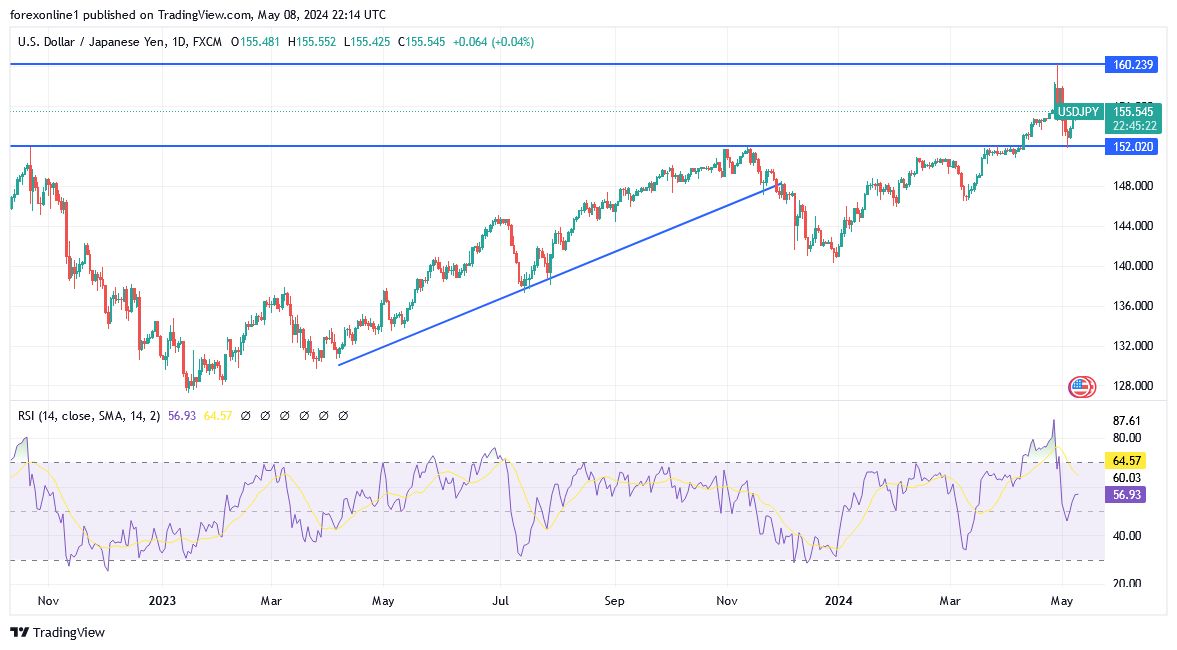- The yen's collapse resumed this week as concerns about the country's economy and interventions continued.
- According to forex trading platforms, the USD/JPY exchange rate has risen for three consecutive days, reaching a high of 155.67 resistance, above its low of 151.92 last week
- . In general, the yen has weakened sharply for over a decade, as the Bank of Japan has adopted low interest rates and quantitative easing policies.
- According to forex trading, the USD/JPY pair bottomed at 75.45 in 2011 and then rose to its highest level in several decades at 160 this month.
- During the same period, the US dollar index rose from 72 dollars to over 105 dollars.

Unlike other central banks around the world, the Bank of Japan has avoided raising interest rates to stimulate inflation in the country. Only, It has achieved a slight increase of 0.10% earlier this year. Overall, Japan faces unique challenges. It is the most indebted country in the G7, with a debt-to-GDP ratio of over 261%.
Top Forex Brokers
Meanwhile, the Bank of Japan holds most of this debt, or about 53%. The Bank of Japan provides this debt simply by printing money. The rest of the debt is held by the likes of insurance companies, banks, foreigners, and pension funds. As a result, the Bank of Japan avoided raising interest rates due to the impact on the country's debt service system. As we saw in the United States of America, higher interest rates lead to more debt servicing costs. Moreover, The US government is expected to pay more than $1 trillion in benefits this year.
In Japan, the Bank of Japan has hinted that it will be cautious when it comes to implementing interest rate hikes, which explains why the Japanese yen has fallen. The recent rise in the currency price occurred when the Bank of Japan released billions of dollars into the market. In most cases, these measures are usually temporary as we saw in 2022. At that time, the bank spent billions to support the currency, but its downward trend resumed when these measures ended.
Furthermore, the potential hope for the Japanese yen is that the US Federal Reserve will start cutting interest rates later this year. Moreover, recent economic numbers have been weak. Consumer confidence and manufacturing production declined while the unemployment rate rose to 3.9%. Meanwhile, hedge funds and other speculators are extremely bearish on the Japanese yen. CFTC data shows that their positions have been in negative territory since December 2021. The latest CoT report put the number at -168.4K, near a multi-decade low of 180K.
USD/JPY Technical analysis and Expectations Today:
The daily chart below shows that the USD/JPY exchange rate peaked at 160.26 resistance on April 29 and subsequently fell to 151.88. historically, this price movement occurred when the Japanese government intervened in the market. As we wrote at the time, the impact of currency interventions tends to be short-lived, which explains why it has rebounded. The pair has broken the retest pattern since the 151.88 swing high in November 2023. Technically, it has remained above all the moving averages, which indicates that the bulls are still in control. Therefore, we think the pair will continue to rise as buyers target the key resistance point at 160 in the next few months.
Eventually, this view may be derailed by the actions of the Federal Reserve, which is expected to begin cutting US interest rates later this year.
Ready to trade our daily Forex forecast? Here’s a list of some of the best online forex trading platforms to check out.
